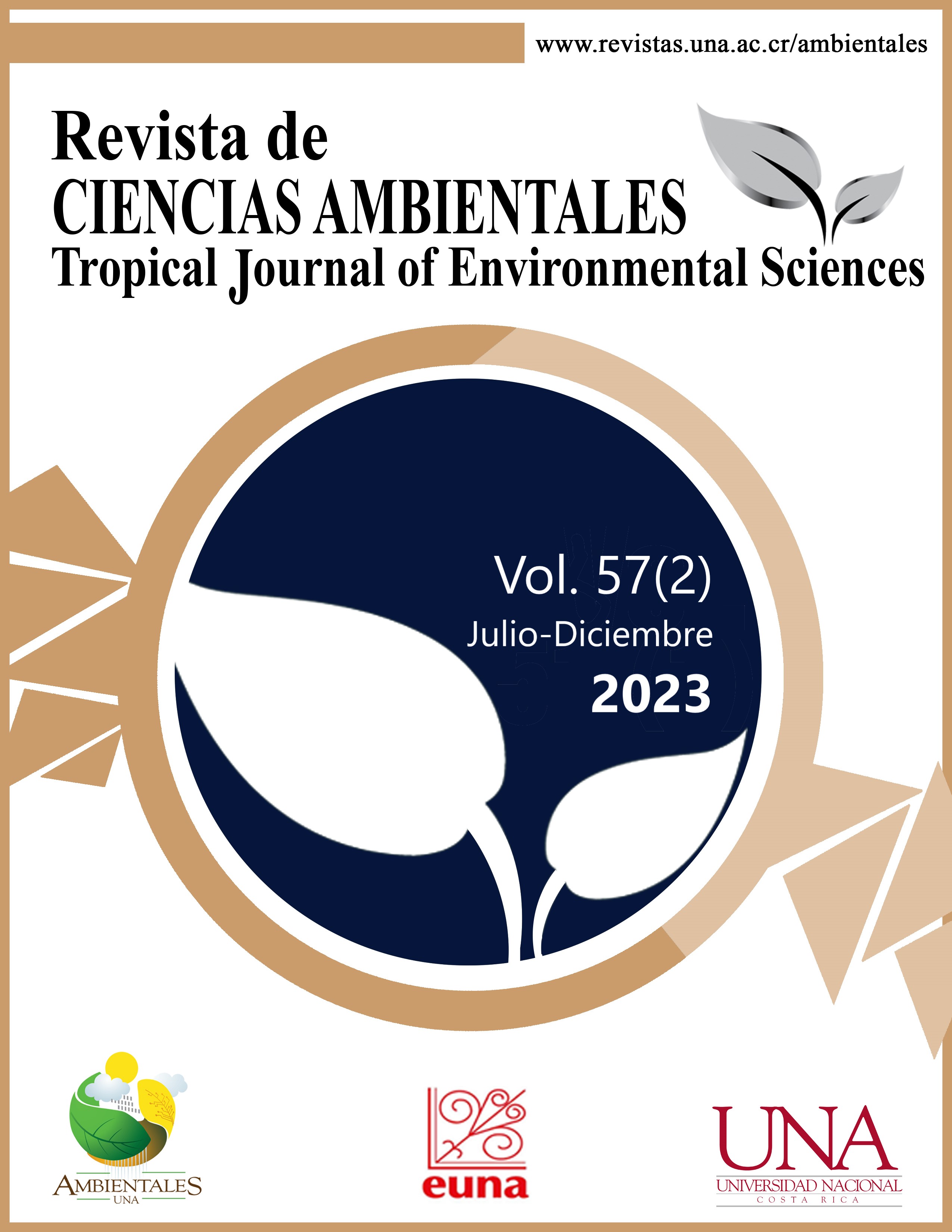Alterações nas moléculas de um petróleo leve submetido a um teste de intemperismo do solo para aplicação em geoquímica forense
DOI:
https://doi.org/10.15359/rca.57-2.8Palavras-chave:
Esteranos; fitano; metildibenzotiofenos; pristano; terpanosResumo
[Introdução]: Quando ocorre um derramamento de petróleo bruto no solo, inicia-se um processo de intemperismo que altera a composição deste recurso e em estágios avançados pode ser irreconhecível em relação ao hidrocarboneto original, dificultando a atribuição de responsabilidades associadas à contaminação desse tipo. [Objetivo]: No presente trabalho, a estabilidade de n-alcanos, hidrocarbonetos aromáticos policíclicos e isoprenóides alifáticos foi analisada em um petróleo leve submetido a um processo de intemperismo do solo em condições de laboratório por um período de um ano, para ser aplicado em disputas relacionadas a derramamentos de óleo e/ou roubos. [Metodologia]: Com base nisso, os perfis das referidas moléculas foram analisados por cromatografia gasosa acoplada à espectrometria de massas das frações brutas. [Resultados]: Em seguida, parâmetros específicos como P/F (pristano/fitano), 4-MeDBT/1-MeDBT (metildibenzotiofenos) e C29αS estigmastano/C30 hopano foram calculados como razões de diagnóstico que não excederam 5 % de sua relação desvio padrão ao longo de um ano. Por outro lado, as razões P/n-C17 (pristano/heptadecano), F/n-C18 (fitano/octadecano), (n-C13 + n-C14)/(n-C25 + n-C26) e ( N0 + N1)/N2 (N = naftalenos) foram os únicos com valores acima de 5 %. [Conclusões]: Esses resultados, somados à análise dos cromatogramas obtidos, sugerem que tanto a evaporação quanto a biodegradação alteraram a composição geral do bruto, no entanto, a maioria dos isoprenóides permaneceu inalterada nas condições de teste ao longo do tempo de estudo, o que demonstra sua capacidade de resolver os problemas descritos.
Referências
Abdulazeez, T. & Fantke, P. (2017). Polycyclic aromatic hydrocarbons. A review. Cogent Environmental Science, 3(1). https://doi.org/10.1080/23311843.2017.1339841
Acuña, A. & Pucci G. (2022). Domestication of an indigenous bacterial consortium to remove hydrocarbons from soils of the Austral Basin. International Journal of Science and Research, 11(5), 1898-1903.
Aeppli, C., Carmichael, C., Nelson, R., Lemkau, K., Graham, W., Redmond, M., Valentine, D. & Reddy, C. (2012). Oil Weathering after the Deepwater Horizon Disaster Led to the Formation of Oxygenated Residues. Environmental Science & Technology, 46(16), 8799-8807. https://doi.org/10.1021/es3015138
Aislabie, J., Balks, M., Astori, N., Stevenson, G. & Symons, R. (1999). Polycyclic aromatic hydrocarbons in fuel-oil contaminated soils. Antarctica, 39(13), 0-2207. https://doi.org/10.1016/S0045-6535(99)00144-7
An, T., Chen, H., Zhan, H., Zhu, Z. & Berndtsson, R. (2005). Sorption kinetics of naphthalene and phenantrene in loess soils. Environmental Geochemistry, 47(4), 467–474. https://doi.org/10.1007/s00254-004-1163-4
Brakstad, O., Daling, P., Faksness, L., Almas, I., Vang, S., Syslak, L. & Leirvik, F. (2014). Depletion and biodegradation of hydrocarbons in dispersions and emulsions of the Macondo 252 oil generated in an oil-on-seawater mesocosm flume basin. Marine Pollution Bulletin, 84(1-2), 125-134. https://doi.org/10.1016/j.marpolbul.2014.05.027
Brown, J., Beckmann, D., Bruce, L., Cook, L. & Mudge, S. (2011). PAH depletion ratios document the rapid weathering and attenuation of PAHs in oil samples collected after the Deepwater Horizon. In: Proceedings of the 2011 international oil spill conference. Portland, Oregon. https://doi.org/10.7901/2169-3358-2011-1-336
Douglas, G., Bence, A., Prince, E., Roger, C., Mc Millen, S. & Butler, E. (1996). Environmental Stability of Selected Petroleum Hydrocarbon Source and Weathering Ratios. Environmental Science & Technology, 30(7), 2332- https://doi.org/10.1021/es950751e
Douglas, G., Hardenstine, J., Liu, B. & Uhler, A. (2012). Laboratory and field verification of a method to estimate the extent of petroleum biodegradation in soil. Environmental Science Technology, 46(15), 8279-8287. https://doi.org/10.1021/es203976a
Faboya, O., Sojinu, S., Sonibare, O., Falodun, O. & Liao, Z. (2016). Aliphatic biomarkers distribution in crude oil-impacted soils: An environmental pollution indicator. Environmental Forensics, 17(1), 27-35. https://doi.org/10.1080/15275922.2015.1091400
Fernández-Varela, R., Andrade, J., Muniategui, S. & Prada, D. (2010). Selecting a reduced suite of diagnostic ratios calculated between petroleum biomarkers and polycyclic aromatic hydrocarbons to characterize a set of crude oils. Journal of Chromatography A, 1217, 8279-8289. https://doi.org/10.1016/j.chroma.2010.10.043
Greenwood, P., Wibrow, S., Suman, J. & Tibbett, M. (2008). Sequential hydrocarbon biodegradation in a soil from arid coastal Australia treated with oil under laboratory-controlled conditions. Organic Geochemistry, 39(9), 0-1346. https://doi.org/10.1016/j.orggeochem.2008.05.005
Kao, N., Su, M., Fan, J. & Chung, Y. (2015). Identification and quantification of biomarkers and polycyclic aromatic hydrocarbons (PAHs) in an aged mixed contaminated site: from source to soil. Environmental Science and Pollution Research, 22(10), 7529-7546. https://doi.org/10.1007/s11356-015-4237-9
Kienhuis, P., Kraus, U. & Kooistra K. (2019). Oil identification. En: Encyclopedia of Analytical Science. (Worsfold P., Townshend A., Poole C. y Miro M. Eds.). UK: Academic Press, pp. 45-52.
López, L. y Infante C. (2021). Cambios en los biomarcadores de la fracción de hidrocarburos saturados en un ensayo de biorremediación con un crudo extrapesado. Revista Internacional de Contaminación Ambiental, 37, 119-131. https://doi.org/10.20937/RICA.53718
Mariano, A., Kataoka, A., Angelis, D. & Bonotto, D. (2007). Laboratory study on the bioremediation of diesel oil contaminated soil from a petrol station. Brazilian Journal of Microbiology, 38, 346-353. https://doi.org/10.1590/S1517-83822007000200030
Munoz, D., Guiliano, M., Doumenq, P., Jacquot, F., Scherrer, P. & Mille, G. (1997). Long-term evolution of petroleum biomarkers in mangrove soil (Guadeloupe). Marine Pollution Bulletin, 34(11), 868-874. https://doi.org/10.1016/S0025-326X(97)00061-1
Olson, G., Gao, H., Meyer, B., Miles, M. & Overton, E. (2017). Effect of Corexit 9500 A on Mississippi Canyon crude oil weathering patterns using artificial and natural seawater. Heliyon, 3(3), e00269. https://doi.org/10.1016/j.heliyon.2017.e00269
Peters, K., Walters, C. & Moldowan, J. (2005). The Biomarker Guide. Biomarkers and Isotopes in the Environment and Human History Reino Unido: Cambridge University Press.
Prince, R., Garrett, R., Bare, R., Grosman, M., Townsend, T., Suflita, J., Lee, K., Owens, E., Sergy, G., Braddock, J., Lindstrom, J. & Lessard, R. (2003). The roles of photooxidation and biodegradation in long-term weathering of crude and heavy fuel oils. Spill Science Technology Bulletin, 8, 145-156. https://doi.org/10.1016/S1353-2561(03)00017-3
Rosell-Melé, A., Moraleda-Cibrián, N., Cartró-Sabaté, M., Colomer-Ventura, F., Mayor, P. & Orta-Martínez, M. (2018). Oil pollution in soils and sediments from the Northern Peruvian Amazon. Science of The Total Environment, 1010-1019. https://doi.org/10.1016/j.scitotenv.2017.07.208
Seguel, C., Mudge, S., Salgado, C. & Toledo, M. (2001). Tracing sewage in the marine environment: Altered signatures in Concepcion Bay, Chile. Water Research, 17, 4166-4174. https://doi.org/10.1016/S0043-1354(01)00146-4
Service, C., Nelson, T., Paquet, P., Mclnes, W., Chris, T. & Service, C. (2012). Pipelines and parks: evaluating external risks to protected areas from the proposed Northern Gateway Oil Transport Project. Natural Areas Journal, 32, 367-376. https://doi.org/10.3375/043.032.0404
Sutton, P., Lewis, C. & Rowland, S. (2005). Isolation of individual hydrocarbons from the unresolved complex hydrocarbon mixture of a biodegraded crude oil using preparative capillary gas chromatography. Organic Geochemistry, 36, 963-970. https://doi.org/10.1016/j.orggeochem.2004.11.007
Toledo, S., Peri, P. & Fontenla, S. (2022). Environmental Conditions and Grazing Exerted Effects on Arbuscular Mycorrhizal in Plants at Southern Patagonia Rangelands. Rangeland Ecology & Management, 81, 44-54. https://doi.org/10.1016/j.rama.2021.11.005
Tomas, G. y Acuña, A. (2023). Estudio de biomarcadores del petróleo a partir de la meteorización de un crudo en agua de mar. Revista Internacional de Contaminación Ambiental, 39, 71-84. https://doi.org/10.20937/RICA.54799
Tomas, G. y Acuña, A. (2022). Biomarcadores aplicados al estudio de crudos extraídos de la Formación Magallanes, Cuenca Austral, Argentina. Boletín de la Sociedad Geológica Mexicana, 74(1), A160621. https://doi.org/10.18268/BSGM2022v74n1a160621
Wang, Z. & Fingas, M. (2003). Development of oil hydrocarbon fingerprinting and identification techniques. Marine Pollution Bulletin, 47(9-12), 423-452. https://doi.org/10.1016/S0025-326X(03)00215-7
Wang, Z., Stout, S. & Fingas, M. (2006). Forensic fingerprinting of biomarkers for oil spill characterization and source identification. Environmental Forensics, 7, 105-146. https://doi.org/10.1080/15275920600667104
Yavari, S., Malakahmad, A. & Sapari, N. (2015). A review on phytoremediation of crude oil spills. Water, Air, and Soil Pollution, 226(8). https://doi.org/10.1007/s11270-015-2550-z
Yim, U., Ha, S., An, J., Won, J., Han, G., Hong, S., Kim, M., Jung, J. & Shim, W. (2011). Fingerprint and weathering characteristics of stranded oils after the Hebei Spirit oil spill. Journal of Hazardous Materials, 197, 60-69. https://doi.org/10.1016/j.jhazmat.2011.09.055
Zhang, H., Yin, X., Zhou, H., Wang, J. & Han, L. (2015). Weathering Characteristics of Crude Oils from Dalian Oil Spill Accident, China. Aquatic Procedia, 3, 238-244. https://doi.org/10.1016/j.aqpro.2015.02.217
Publicado
Como Citar
Edição
Seção
Licença
A partir del 17 de mayo del 2018 la licencia ha sido actualizada a:

Esta obra está bajo una Licencia Creative Commons Atribución-NoComercial-CompartirIgual 4.0 Internacional.















